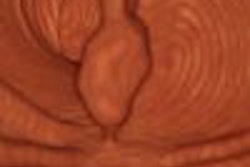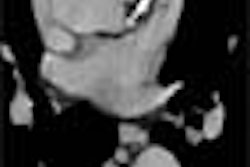In the past decade, as injuries due to radiation exposure from fluoroscopy have increased, physicians have been exploring technologies that might better protect the radiologists who do the procedures. A group from Japan is reporting successful results with a needle holding device and a lead plate for decreasing dose.
Dr.Toshiyuki Irie and colleagues from the University of Tsukuba in Ibaraki conducted CT fluoroscopic interventional procedures using various combinations of protective devices and techniques in an effort to find ways to reduce radiation dose to interventional radiologists (Journal of Vascular and Interventional Radiology, December 2001, Vol. 12: 12, pp. 1417-1421).
Between December 1998 and December 2000, the team evaluated 55 CT fluoroscopy-guided interventional procedures, including 23 lung nodule biopsies, 13 paraaortic lymph node biopsies, and seven markings before video-assisted thoracic surgery. Radiologists performing the procedures wore finger radiation detectors to measure the scattered radiation dose to their hands. Continuous observational and short-term techniques were used both in combination and intermittently.
Irie and his team used three instant intervention (I-I) devices, each made of acrylate resin and consisting of two columns, one for holding the device in place so that the user could control it by hand, and the other for holding the needle. The first and original device, made by Hakko Medical of Tokyo had a distance of 7 cm between columns; the two new devices (also made by Hakko) have distances of 10 cm and 15 cm between the two columns.
The two new devices were also improved by the addition of a target-marking mechanism: stainless-steel plates on each side of the needle column, which produced two lines on the CT image that aided users in accurately placing the needle.
The researchers also used a 30-cm long by 20-cm wide by 2-mm thick lead plate that was placed on the patient, then wrapped around the I-I device and the physician’s hand. Procedures were conducted on a Toshiba X-Vigor Laudator fitted with CT fluoroscopy with 120 kV or 135 kV in tube voltage, and 1-mm or 5-mm slice thickness. Tube rotation was 0.75 seconds, with eight frames shown per second. The team used either 40-cm or 26.7-cm field-of-view settings.
Over the course of the study period, Irie and his colleagues improved the I-I device, began using the lead plate, and changed the procedure dose. Patients were retrospectively divided into six groups to reflect these changes:
- Group A - 135 kV, 5 mm slice thickness, 7-cm I-I device used, no lead plate, 126.3 mSv/mA/sec x 100,000 dose rate
- Group B - 120 kV, 5-mm slice thickness, 7-cm I-I device used, no lead plate, 75.2 mSv/mA/sec x 100,000 dose rate
- Group C – 120 kV, 5-mm slice thickness, 7-cm I-I device used with lead plate, 17.8 mSv/mA/sec x 100,000 dose rate
- Group D – 120 kV, 5-mm slice thickness, 10-cm I-I device used with lead plate, 13.9 mSv/mA/sec x 100,000 dose rate
- Group E – 120 kV, 5-mm slice thickness, 15-cm I-I device used with lead plate, 2.8 mSv/mA/sec x 100,000 dose rate
- Group F – 120 kV, 1-mm slice thickness, 10-cm I-I device used with lead plate, 4.1 mSv/mA/sec x 100,000 dose rate
Comparisons were made between groups A and B (120 kV versus 135 kV), B and C (lead plate use versus non-use), D and F (5 mm versus 1 mm slice thickness), and C, D, and E (type of I-I device).
The study found that the use of the lead plate reduced radiation dose by 76%, while the use of the 15 cm I-I device reduced the dose by 84%. A 120 kV current reduced the dose by 40%, and the 1-mm collimation decreased the dose by 71%. Overall, radiation doses to physicians were reduced from 2 mSv per case to 0.1 mSv per case or lower.
Irie and colleagues currently use the 15-cm device regularly at the university’s Tsukuba’s Institute of Clinical Medicine, Irie told AuntMinnie.com. The original 7-mm I-I is currently available only in Japan, and is priced at around $300 (U.S.).
The learning curve for radiologists using the instant intervention devices depends on the physician’s experience, according to Irie.
"When the physician is familiar with the conventional CT guided intervention, one to two cases are sufficient to understand and become familiar with CT-fluoro guided intervention using the I-I device," he said. "If the physician is not as experienced, three to seven cases are required."
By Kate Madden YeeAuntMinnie.com contributing writer
February 5, 2002
Related Reading
Fluoroscopy safety demands a plan, October 11, 2001
CT dose study is good news for interventional radiologists, October 5, 2001
Low-dose CT fluoroscopy minimizes interventional exposure, July 30, 2001
Proposed U.S. rules increase safety and cost of fluoroscopy systems, August 16, 2000
Copyright © 2002 AuntMinnie.com




















